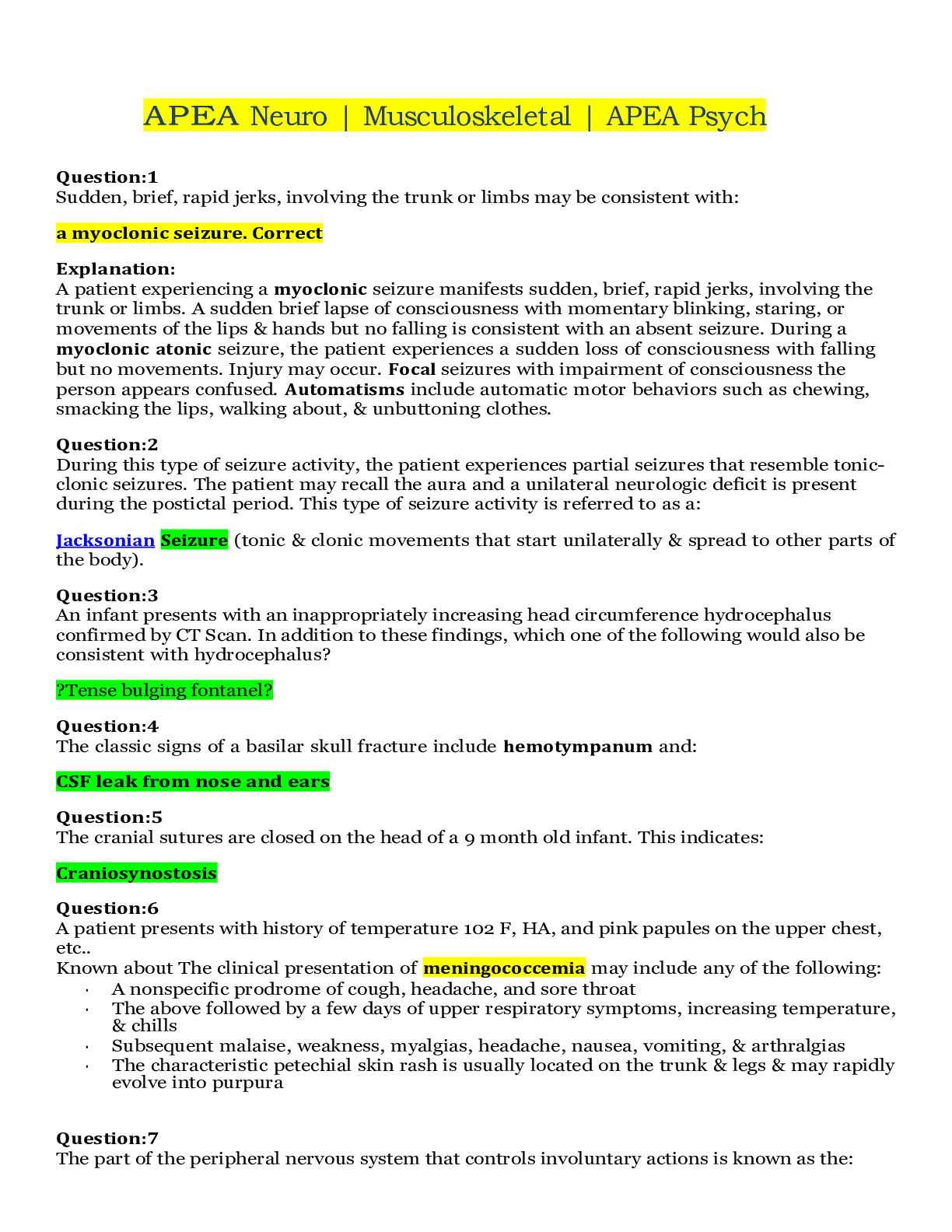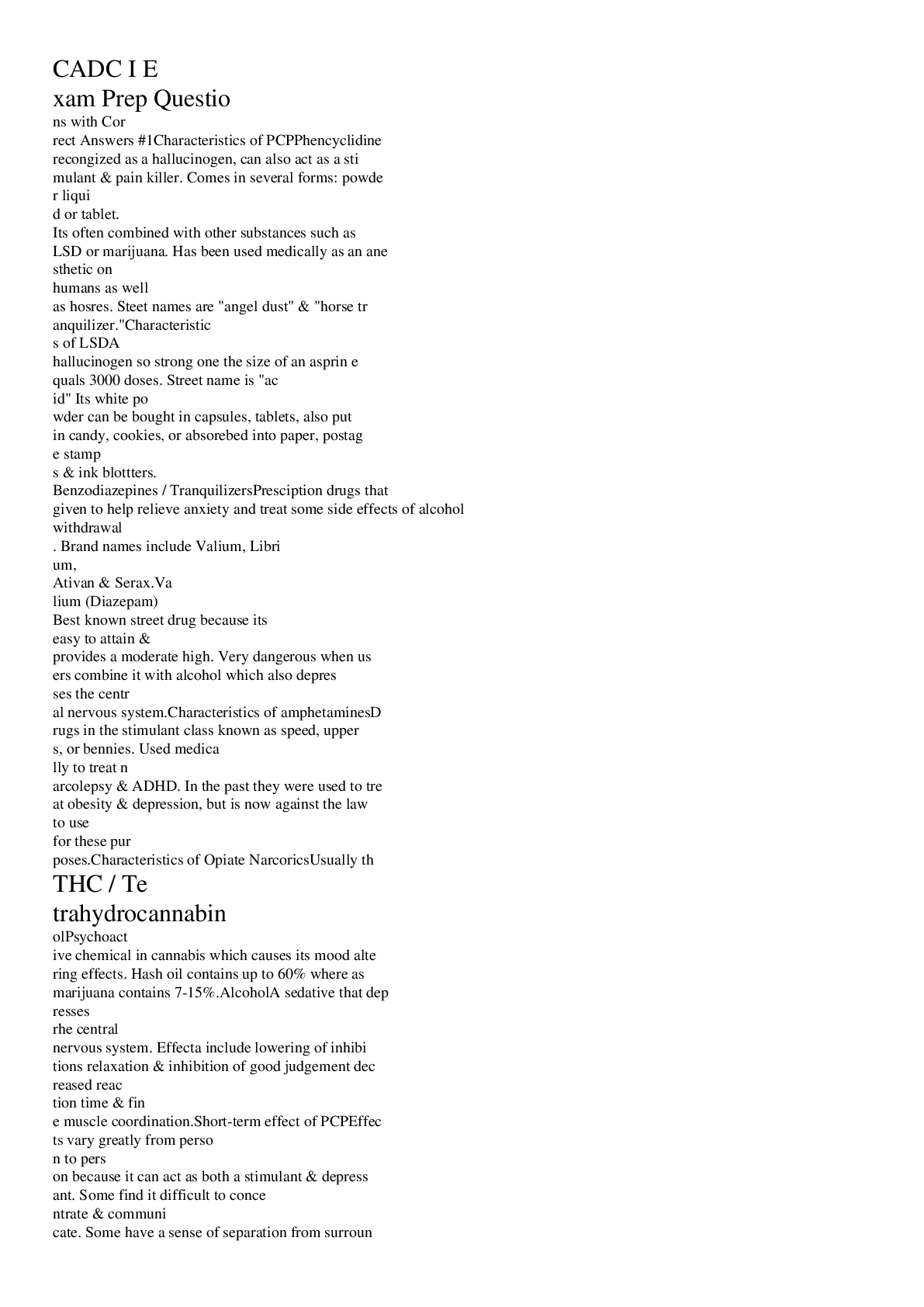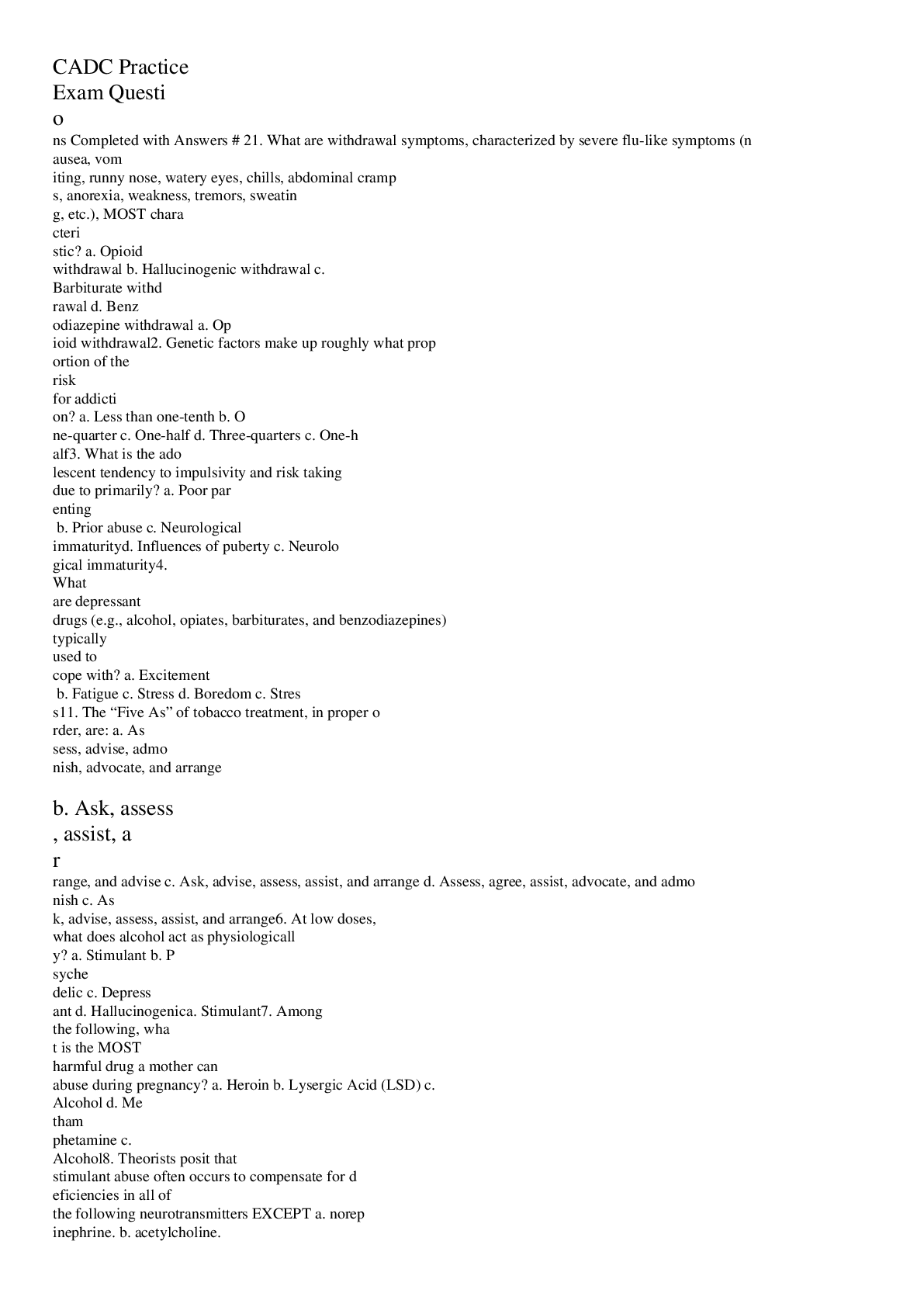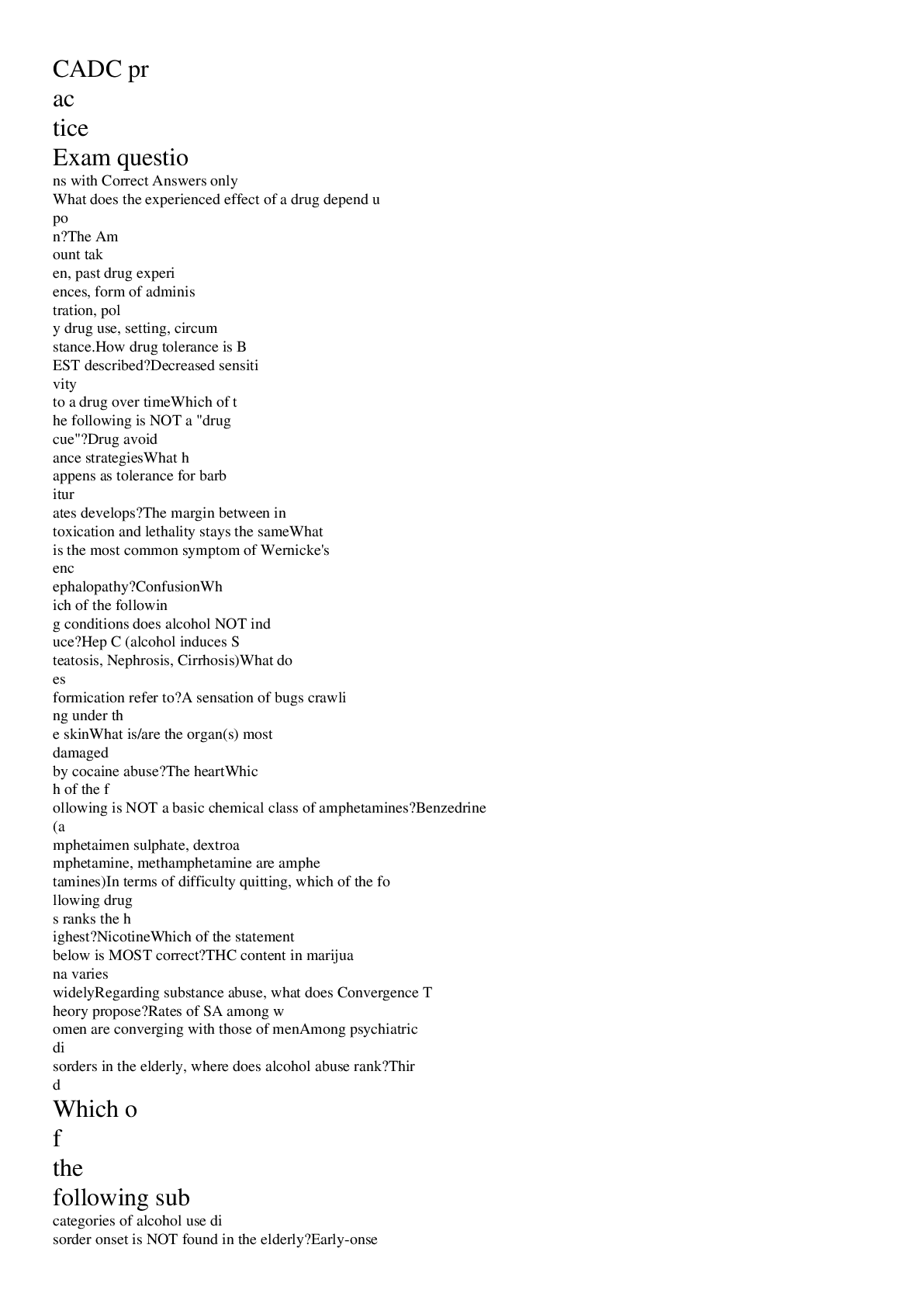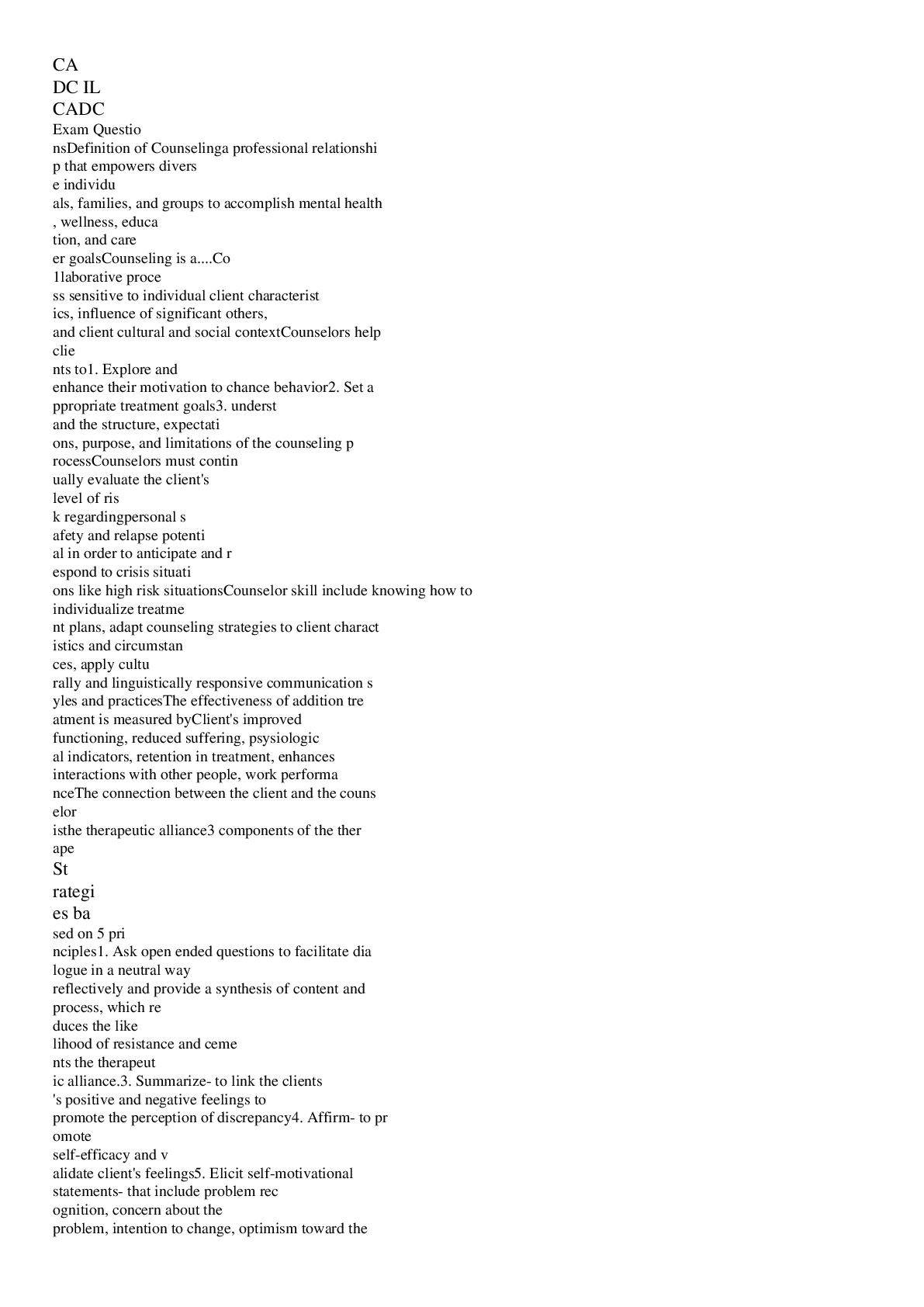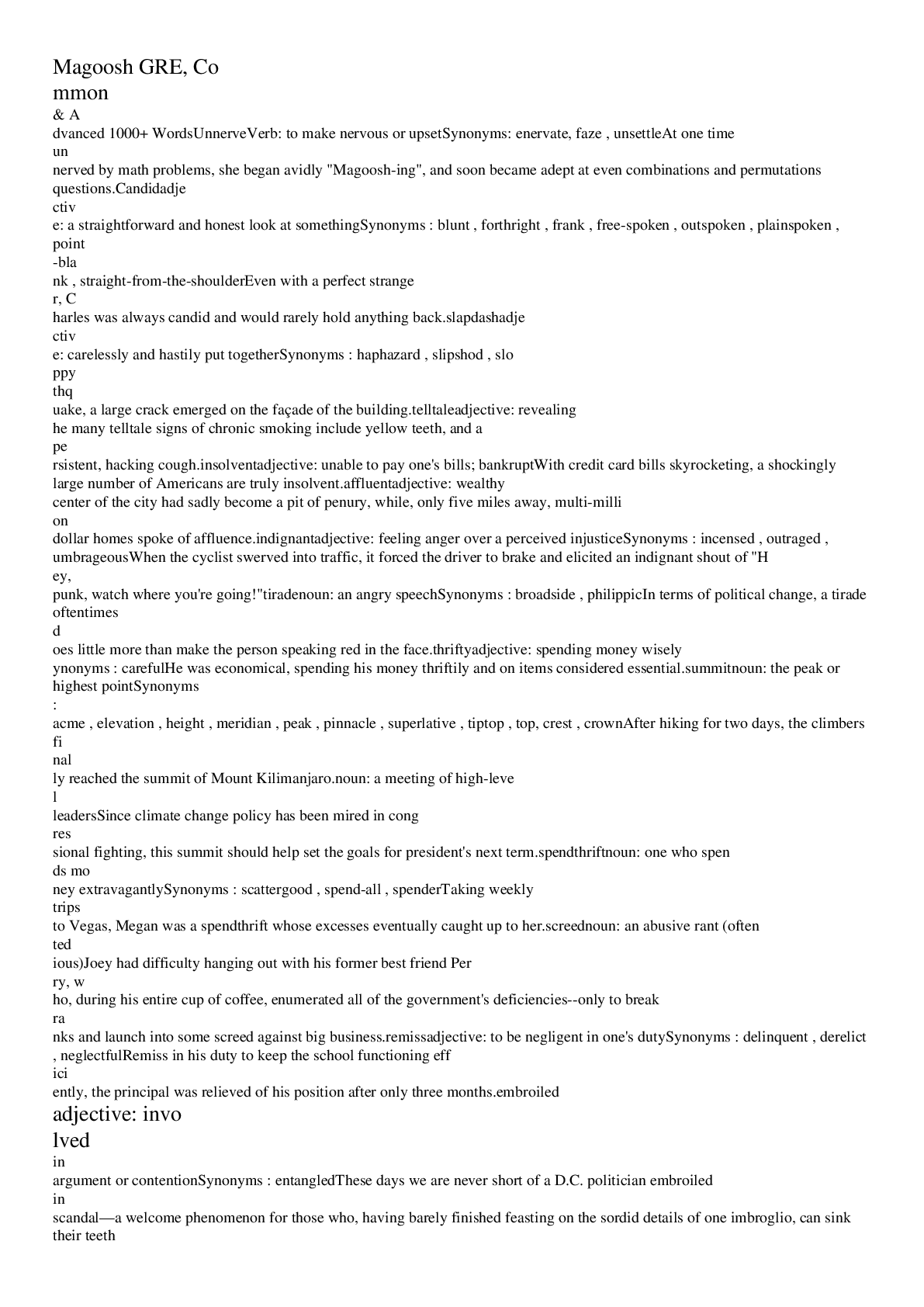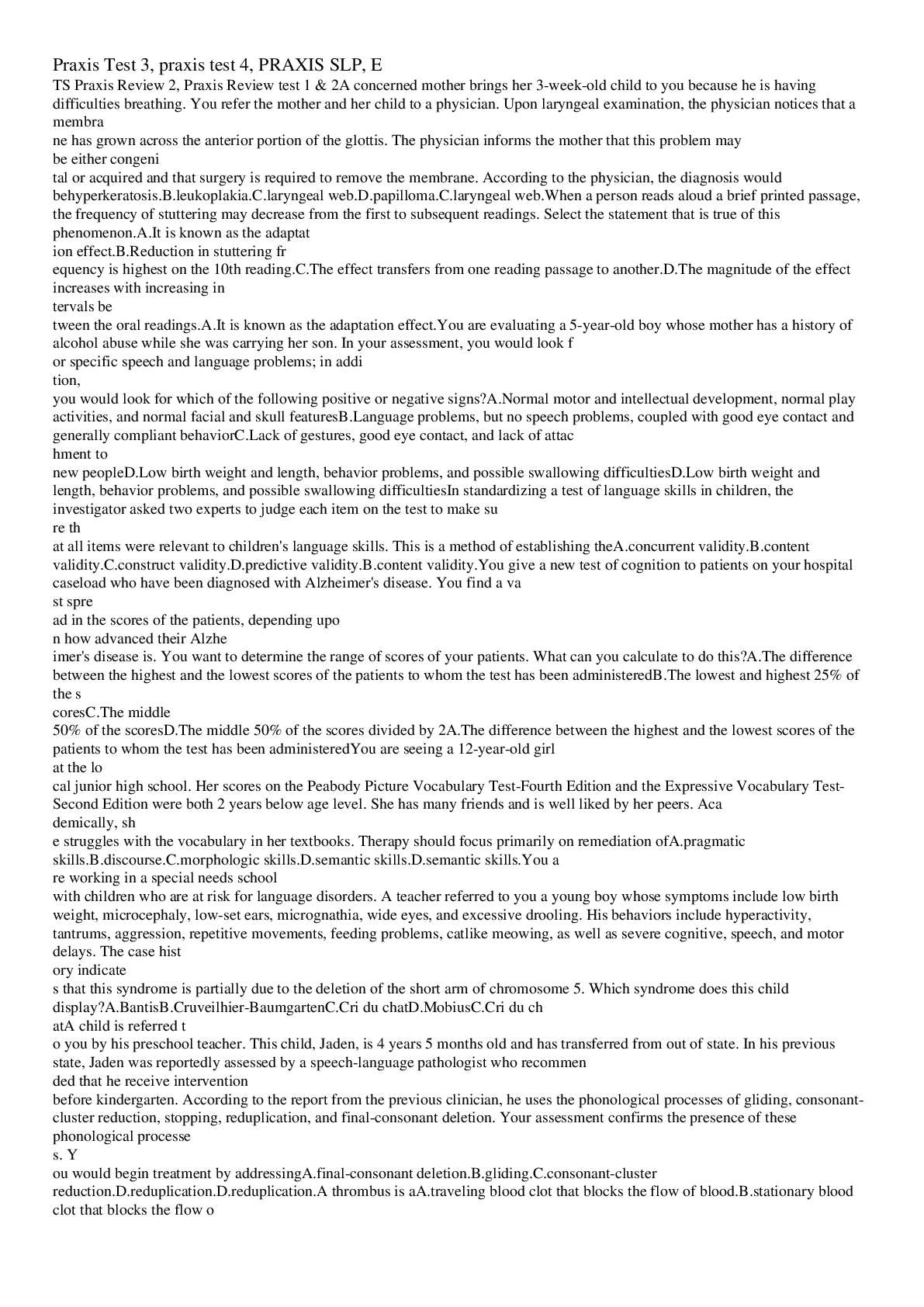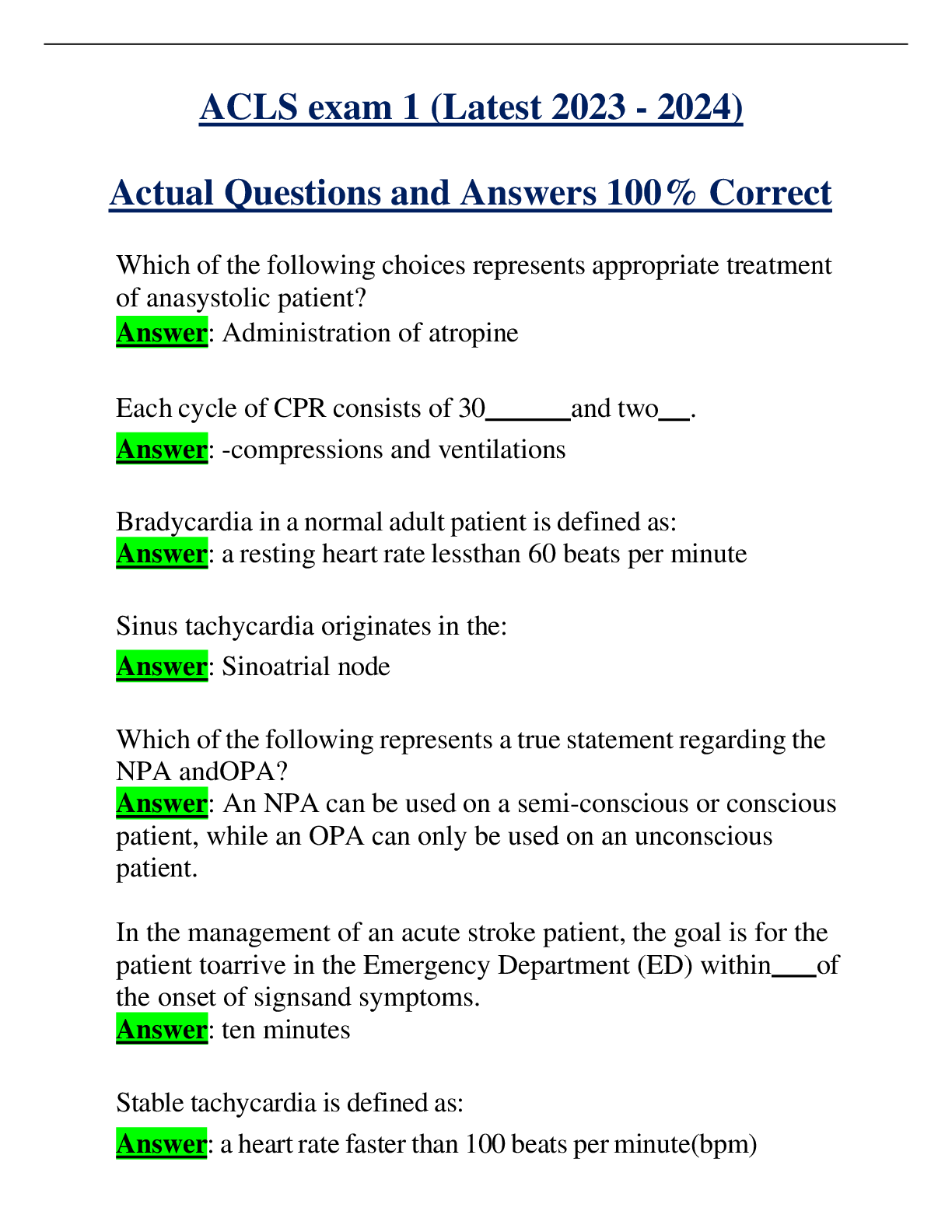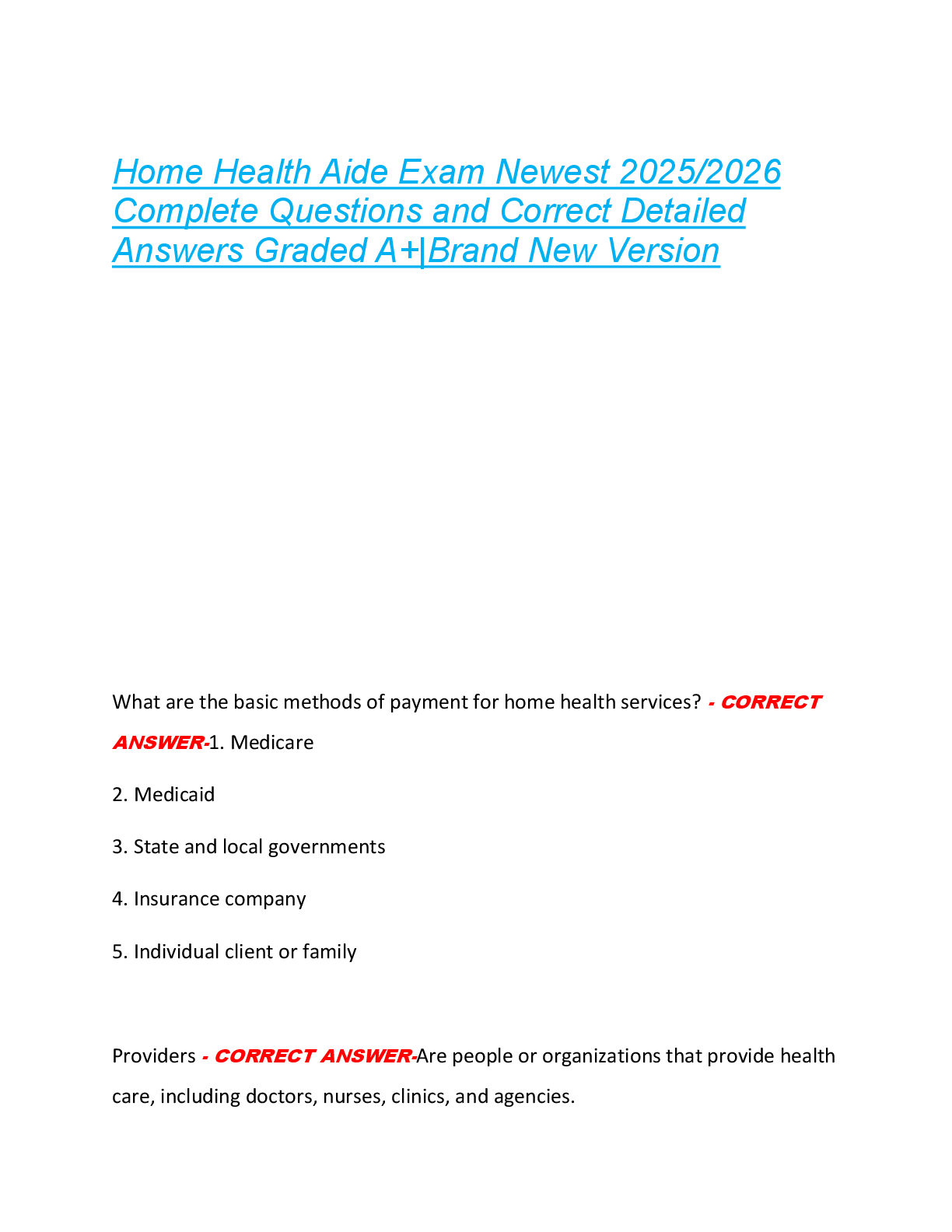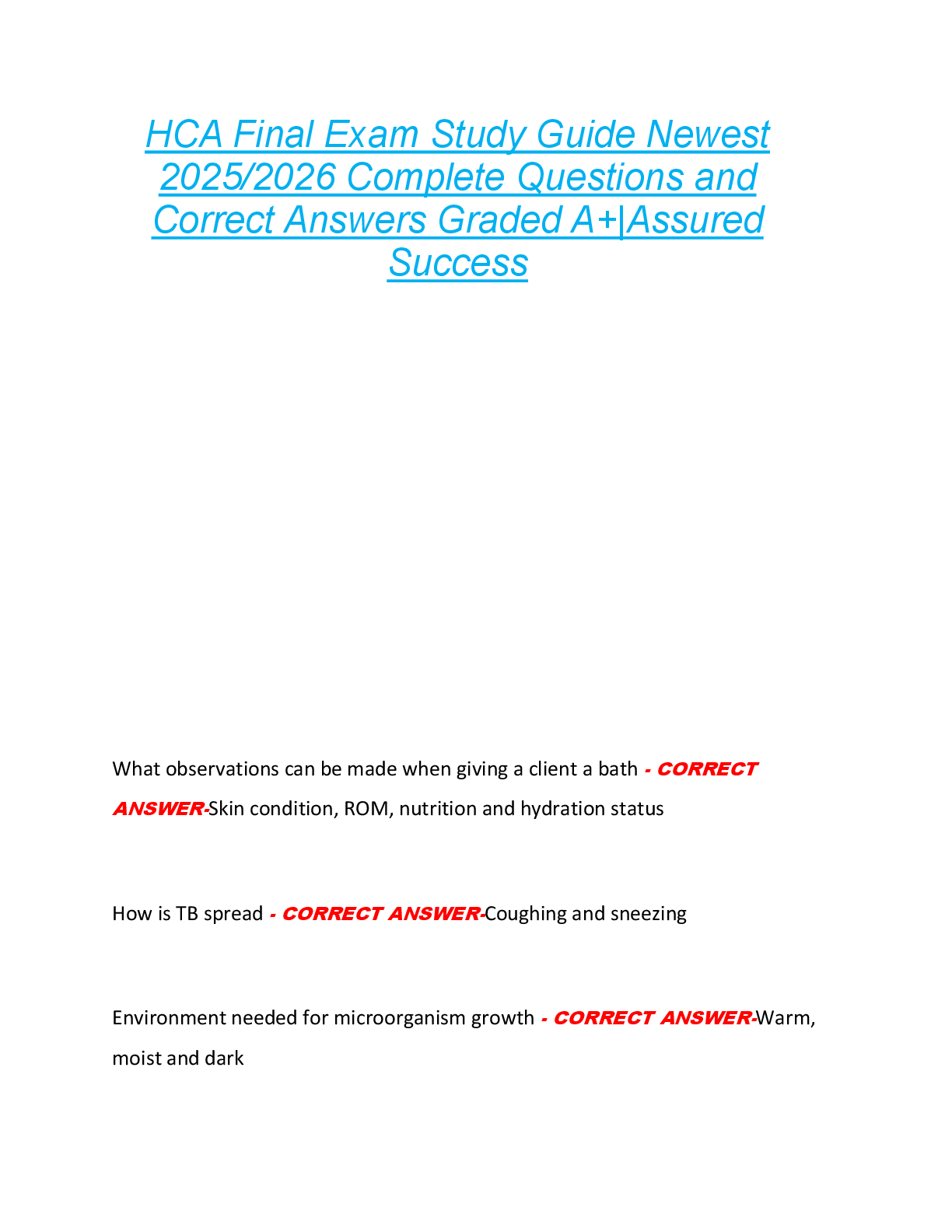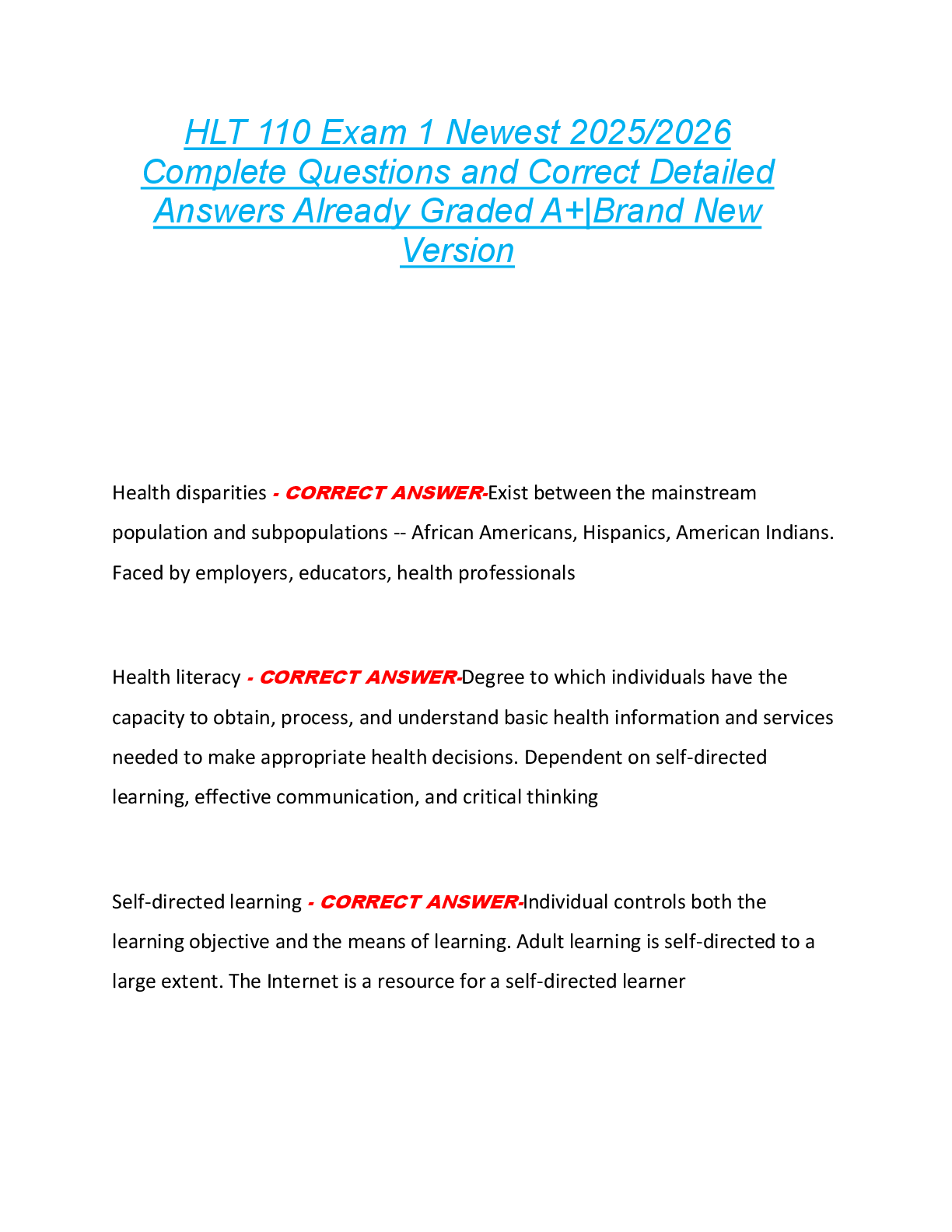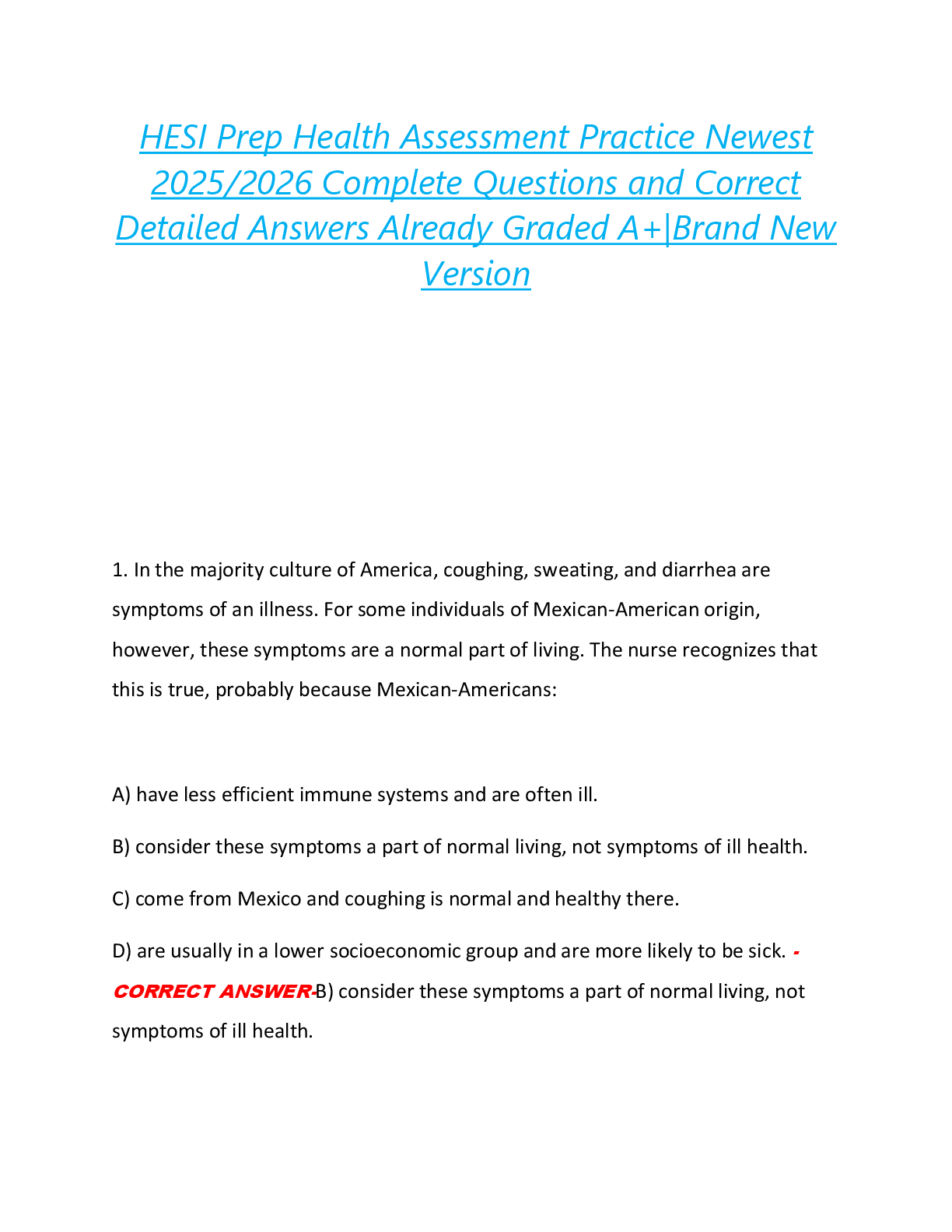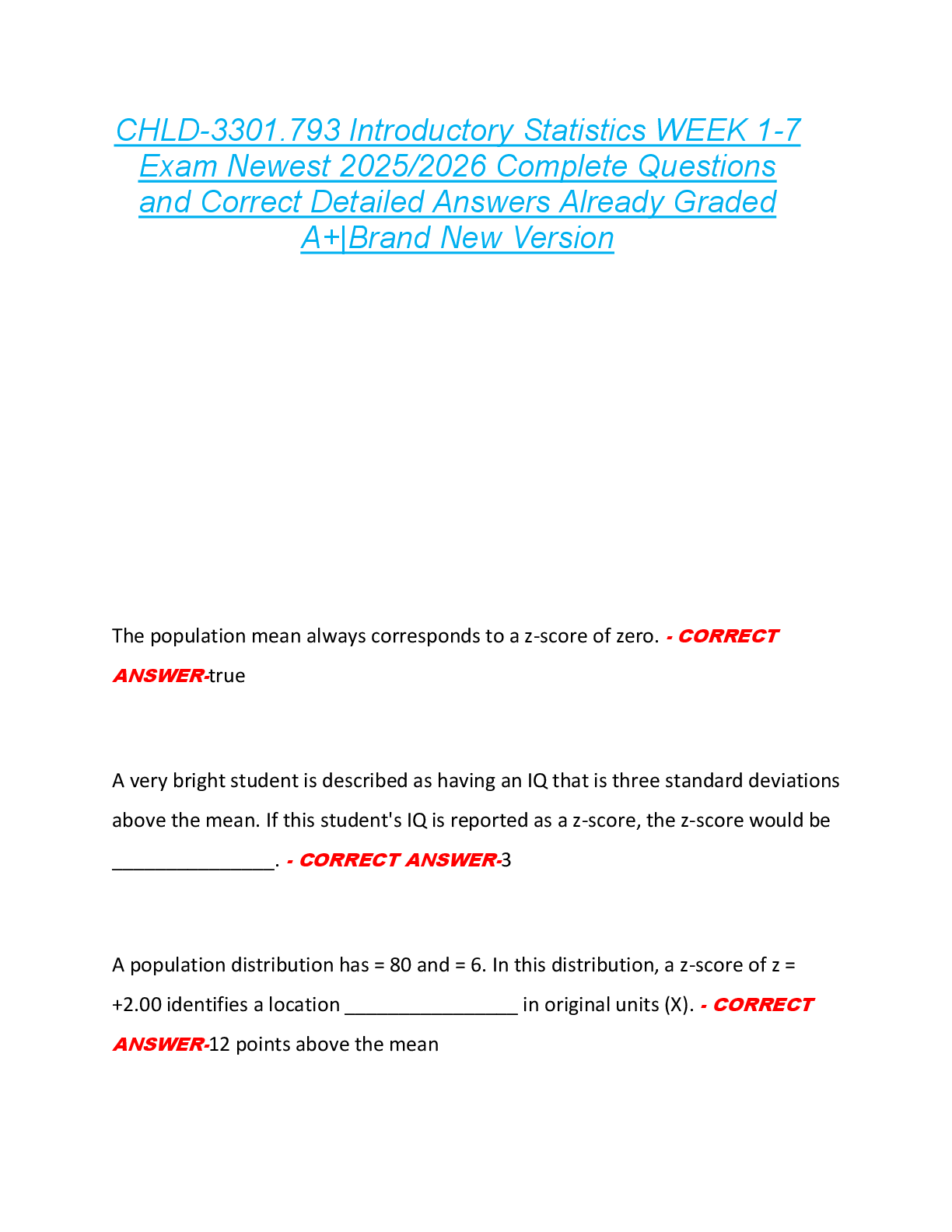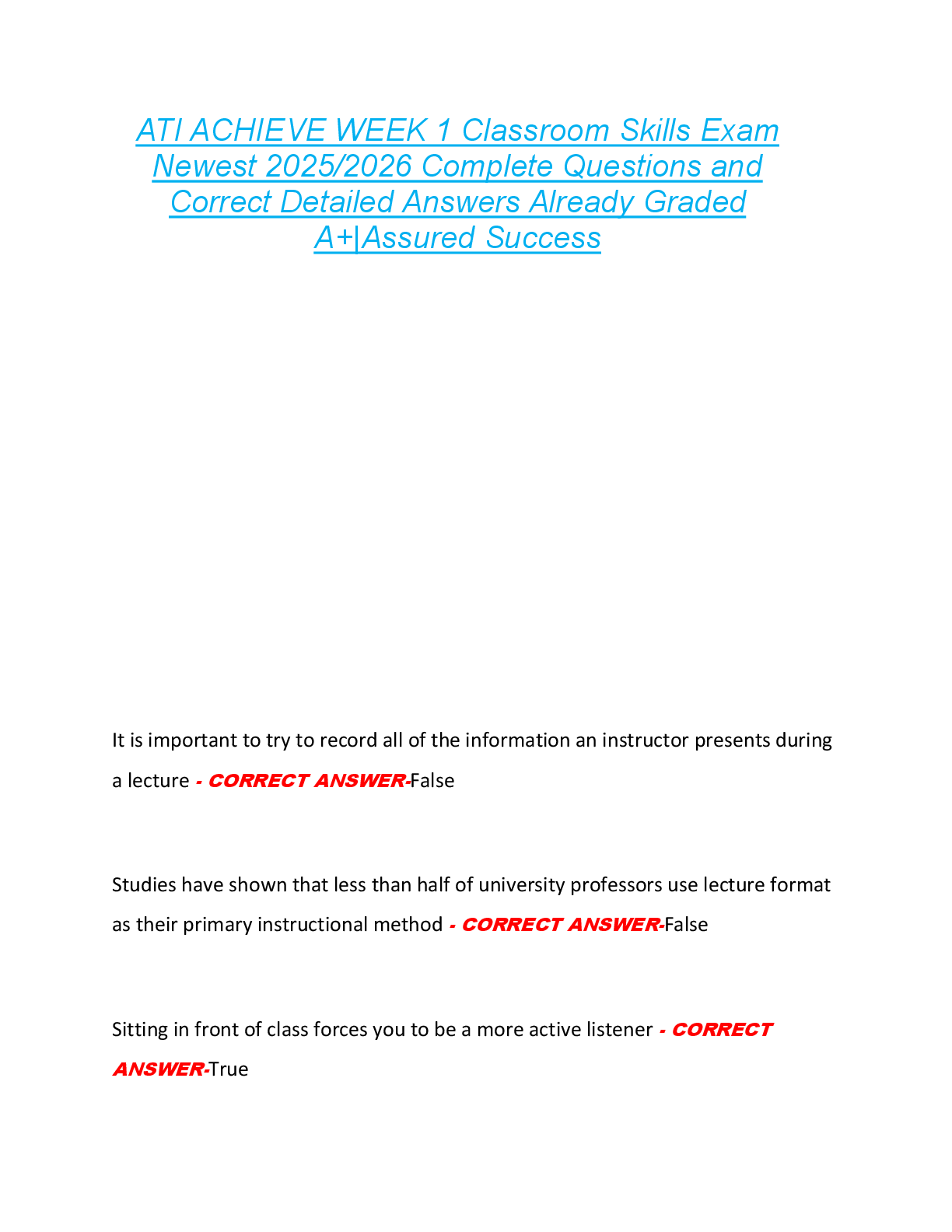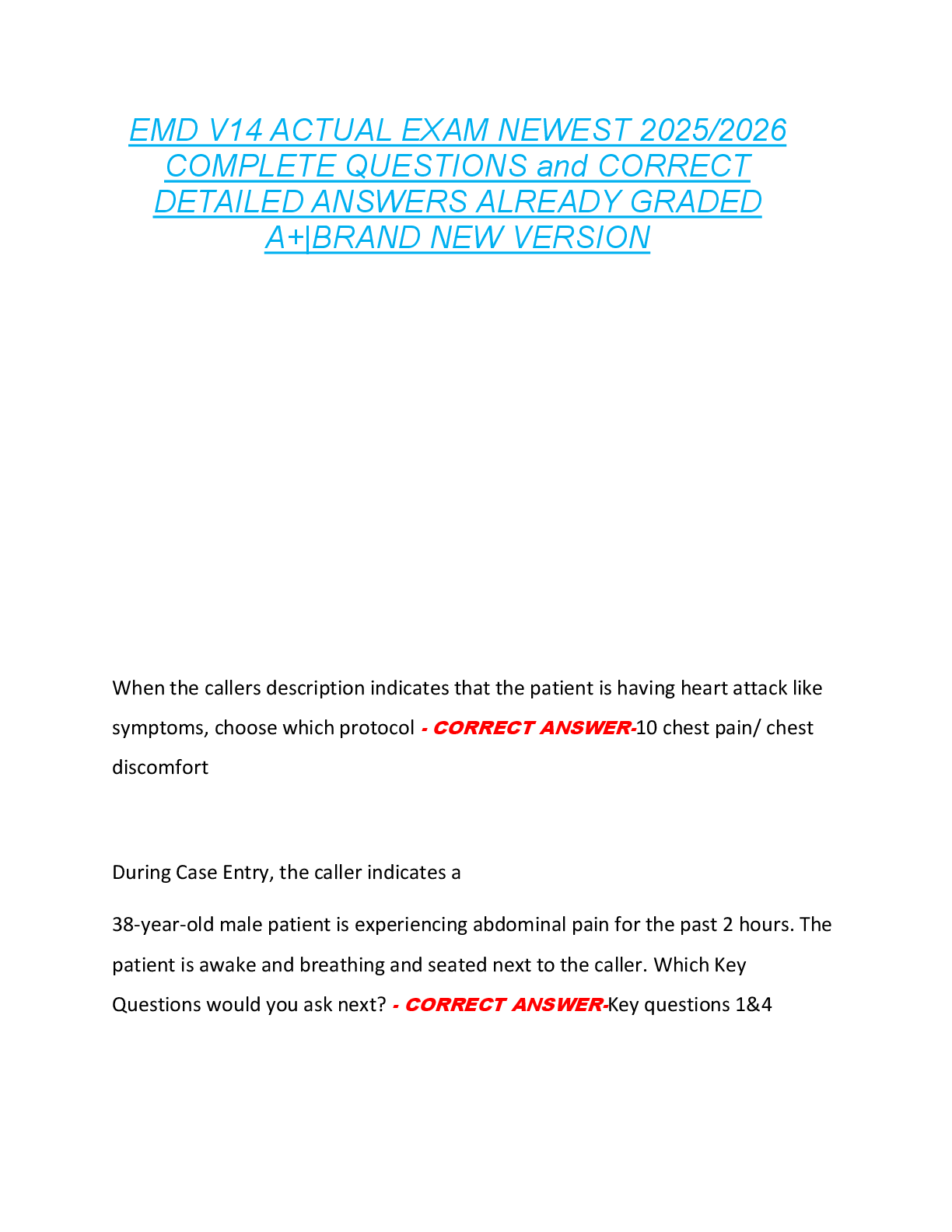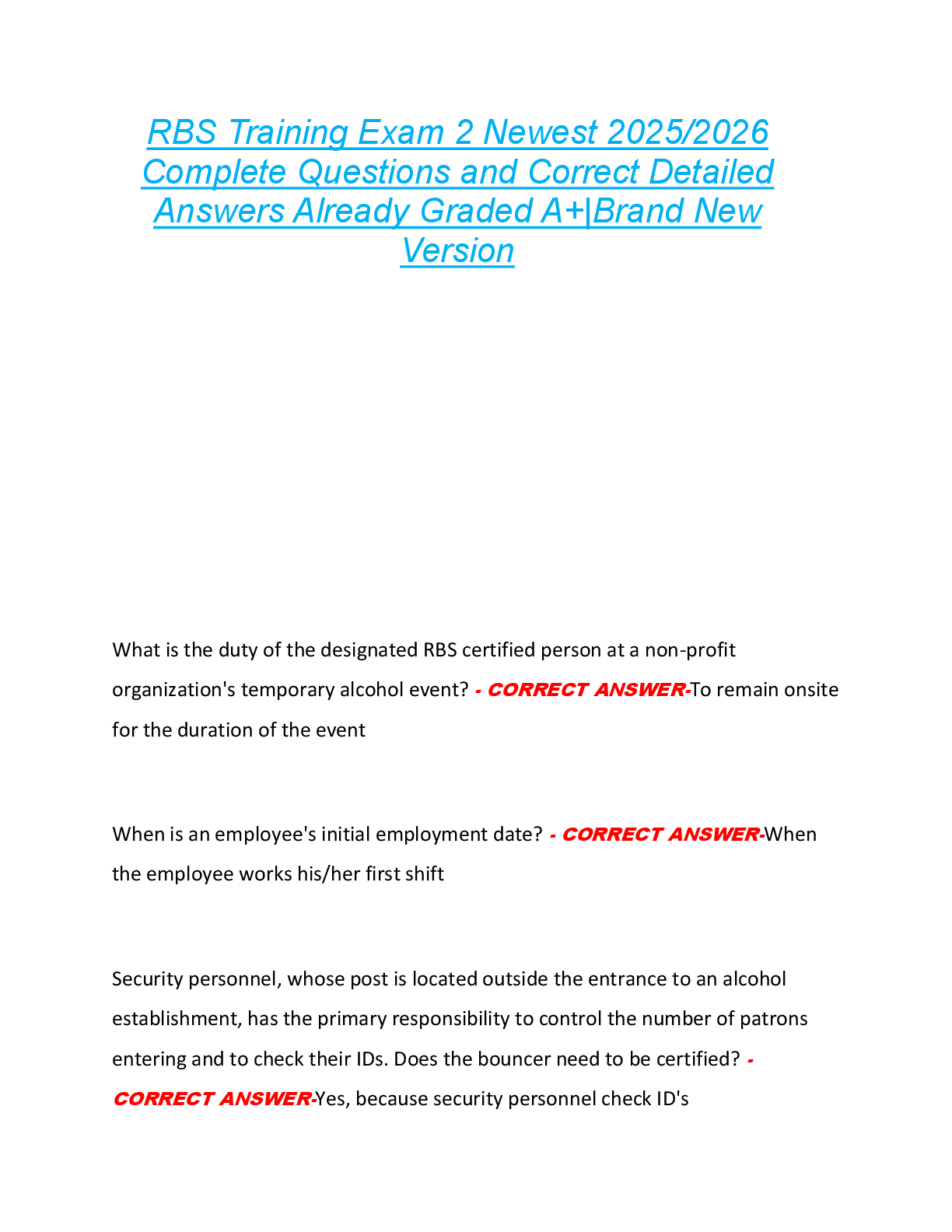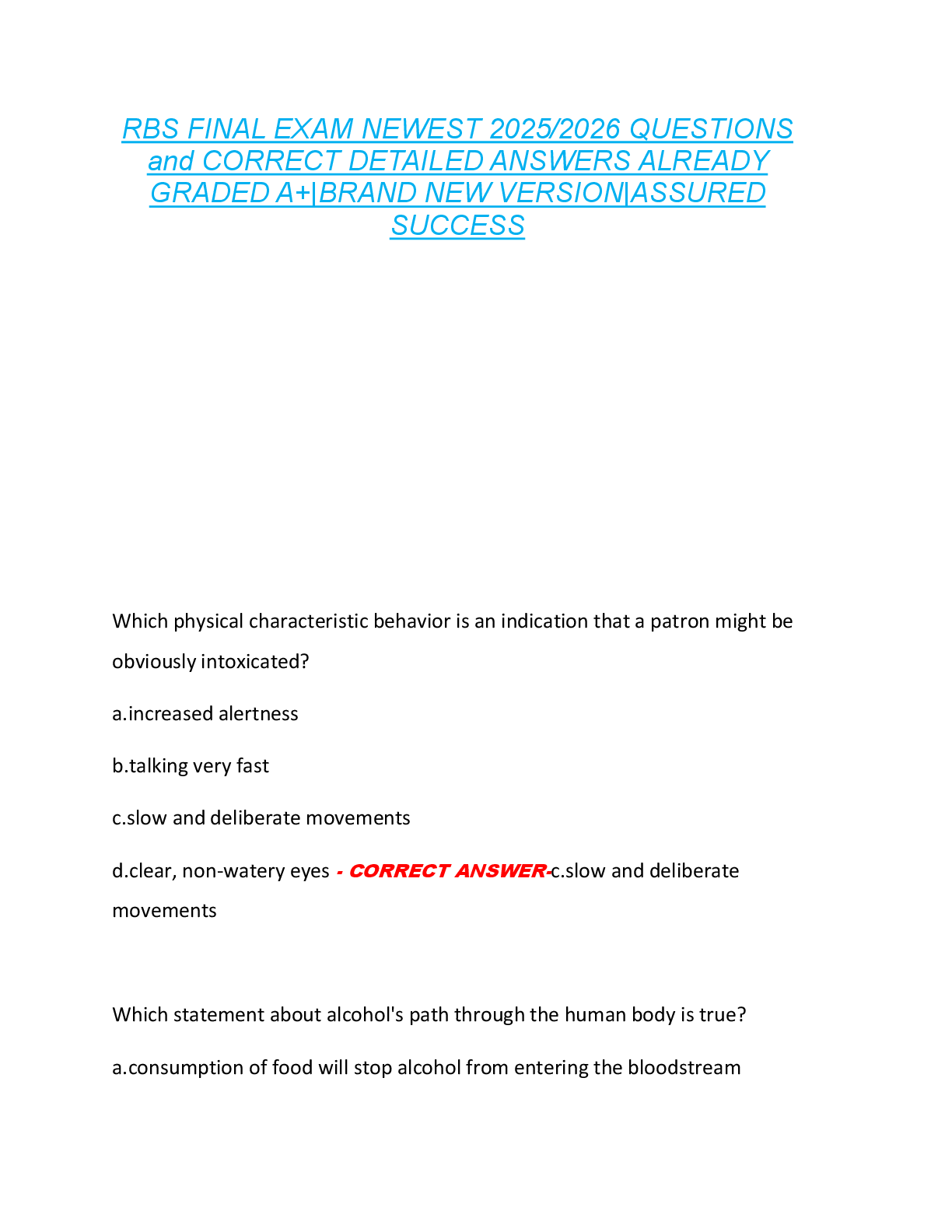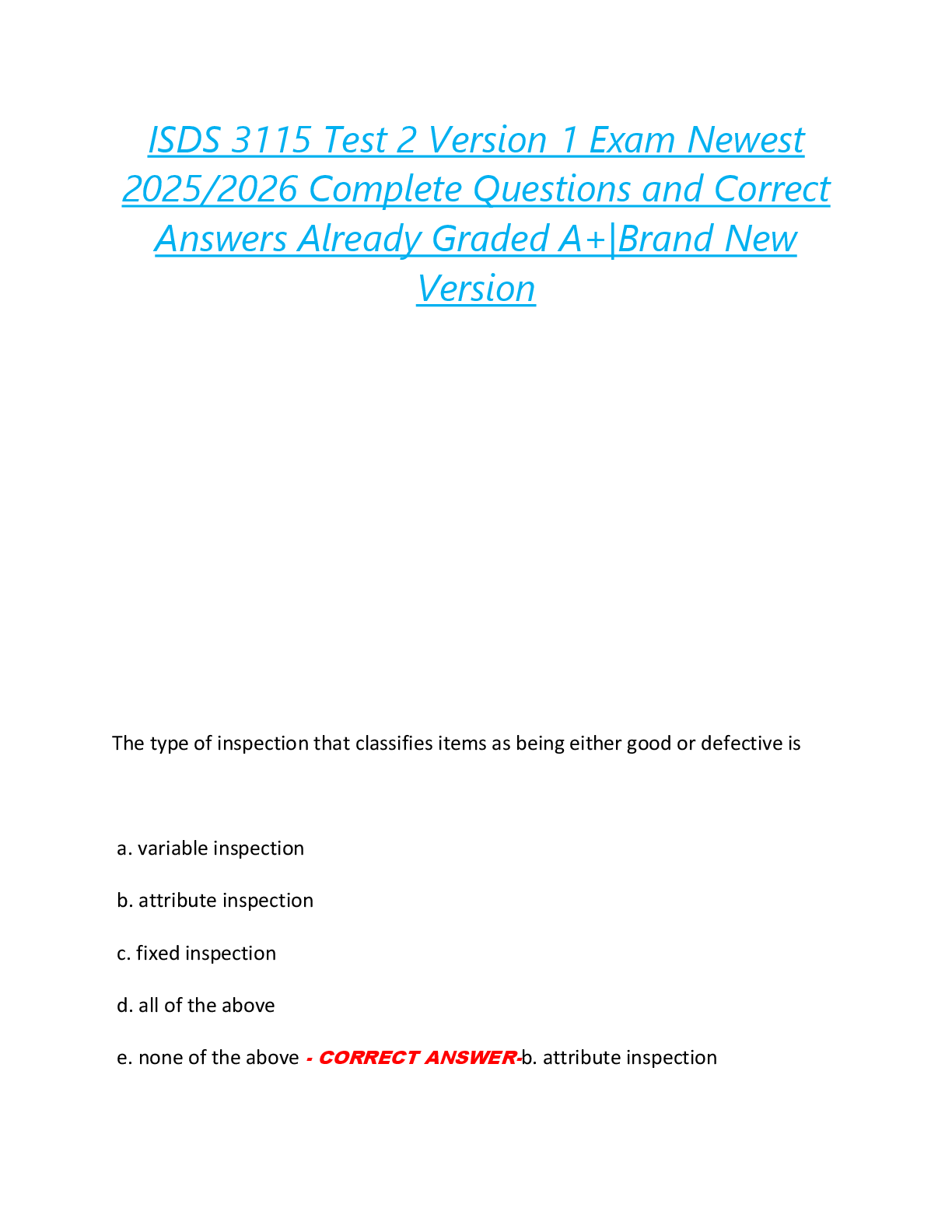Counseling > EXAM > CADC Sample Exam Multiple Choice Questions (Excellently Answered) (All)
CADC Sample Exam Multiple Choice Questions (Excellently Answered)
Document Content and Description Below
CADC Sample Exam Multiple Choice Questions (Excellently Answered) CADC Sample Exam Multiple Choice Questions (Excellently Answered) Which of the following is the BEST definition of insight? a. A ... problem solving strategy involving the elimination of unworkable solutions b. A sudden understanding of self, or realization of ow a problem can be solved c. A Freudian defense mechanism that is used unconsciously but not maliciously d. A confrontation technique used in conjunction with Gestalt therapy b MAT refers to: a. a common screening tool for alcoholism b. a lengthy personality inventory used to identify gross psychopathology c. the use of medications such as suboxone in the treatment of addiction d. a nonmedical detox protocol c Aisha has completed her treatment at an in-patient facility and is ready to be discharged. She has asked her counselor to recommend a therapist to work with her and her husband on an out-patient basis. This process is BEST viewed as an example of: a. a referral b. a consultation c. case management d. an aftercare plan a Which type of therapy is most directive, offering the greatest potential for abuse of power by the counselor? a. Adlerian b. Rational-emotive c. Gestalt d. Person-centered c The primary purpose of professional credentialing for counselors is to: a. advance the field by ensuring that counselors are recognized as dignified professionals b. ensure that counselors share and understand the accepted philosophies of practice c. protect public safety by ensuring that counselors meet minimum standards of competency d. ensure that counselors receiving third-party payments have professional credentials c Which of the following is NOT a CNS depressant? a. Alcohol b. Xanax c. Nembutal d. Benzedrine d The concept of informed consent requires that before agreeing to accept treatment, clients should know their rights and obligations, therapeutic goals, fees for services and a. availability of referral services b. community resources to be used c. with whom they will be participating in group activities d. the limits of their confidentiality d Attitudes, policies, and practices that are destructive to other cultures and their members are examples of lack of cultural a. blindness b. competence c. destructiveness d. incapacity b Restlessness, nervousness, flushed face, muscle twitching, tachycardia, or cardiac arrhythmia are all signs or symptoms of: a. caffeine intoxication b. cocaine intoxication c. alcohol intoxication d. opioid intoxication a Of all of the possible substance use disorders, which one is typically not seen in older children or adults? a. cannabis use disorder b. inhalant use disorder c. tobacco use disorder d. caffeine use disorder b Needle exchange programs can BEST be described as: a. a nonabstinence technique b. harm reduction c a maintenance method d. a community organization intervention b Autonomic hyperactivity, hand tremor, nausea or vomiting, psychomotor agitation, grand mal seizures are all signs or symptoms of: a. cannabis withdrawal b. cocaine withdrawal c. sedative, hypnotic, or anxiolytic withdrawal d. opioid withdrawal c Among other things, _____ involves making a client aware of resources in the community, as well as providing information related to substance abuse, HIV/AIDS and other STDs a. case management b. referral c. client education d. consultation c In the United States the population that experiences the lowest prevalence of alcohol use disorder is: a. caucasian men b. adult women c. native americans d. asian americans and pacific islanders d Classical and operant conditioning are associated with _____ therapy a. cognitive b. behavior c. gestalt d. person-centered b Eric has admitted being sexually active without using any type of protection against sexually transmitted diseases. His counselor has made an appointment for him to be tested for the HIV virus. He then made arrangements for Eric to be transported to the clinic. Facilitating this appointment is BEST described as: a. consultation b. case management c. client education d. ethical responsibility b Studies indicate that counseling is most effective when: a. culture and values are taken into account b. the counselor relies on humanistic methods c. the therapist and the client come from similar backgrounds d. a therapeutic contract is clarified in the first session a One basic principle of documentation requires the counselor to: a. describe events as vaguely as possible in case records are requested for a court case b. describe events in objective terms, using measurable language that can be easily understood c. only document group notes, because any twelve step work is not counseling d. document emotions based only on what the client reports, because the counselor's assessment will always be subjective b The _______ model of addiction as a consequence of personal choice a. disease b. moral c. social d. sociocultural b How does solution-focused brief therapy differ from many of the other approaches to counseling? a. Emphasis is placed on the present and future while devaluing the past b. It emphasizes the use of more abstract techniques, such as empty chair c. Greater attention is paid to the particular pathology and associated problems d. More time is spent attempting to understand the problem a Case reviews: a. encourage the sharing of information b. promote client growth c. allow the client the opportunity to offer feedback d. enable the counselor to assess progress and make any necessary changes in the treatment plan d The tendency of the family to try and maintain balance when dealing with a loved one's substance use disorder is called: a. equilibrium b. stability c. homeostasis d. accommodation c Your client expresses growing feelings of rage. He has recurring nightmares in which he attacks random women on the street. If you followed through with what you believed was a duty to warn, under what circumstances would you be least likely to be disciplined? a. if the nightmares had escalate in intensity b. if the client was already a convicted criminal c. if the client refuses to answer questions about violent behavior d. if the client discloses the name of a person he plans to harm d In his second counseling session, a client reveals to the counselor that he is gay. Having never worked with a member of this special population, the counselor's BEST course of action is to: a. inform the client of his lack of knowledge of the gay community and commitment to learn. b. offer to refer the client to someone with experience in with special issues associated with the gay community. c. send the client a letter informing him that he has been transferred to another counselor's caseload. d. say nothing because counseling should be value-neutral anyway. b Determining a client's eligibility and appropriateness for treatment occurs during the _______ process a. intake b. assessment c. admission d. screening d Highly structured daily routines, a system of rewards and punishments, and frequent group confrontation are characteristics of: a. intensive out-patient treatment b. therapeutic communities c. any primary care setting d. gestalt b Collateral interviews: a. involve asking significant others about their opinions as to whether or not a person has a substance abuse dependency problem. b. do not require release of information documents if the information is voluntarily given. c. involve gathering information from other persons who are or have been, associated with the person being assessed. d. should only be done with immediate family members and no one else. c A major criticism of the ______ is that the questions are so obvious that this test cannot possible detect alcoholics who deny having a problem. a. MAST b. ASI c. SASSI d. POSIT a The goal of complete abstinence is most consistent with the _____ model of addiction. a. moral b. disease c. sociocultural d. psychological b _______ can develop between natural and synthetic opiates, but not between opiates and CNS depressants. a. Nonsynergistic interaction b. Gestalt c. Cross Tolerance d. Negative Symptoms c Appropriate treatment goals must be: a. observable and measurable, in order to facilitate monitoring progress. b. typed and signed in order to ensure compliance by an unwilling client. c. written in the order that they will be addressed in treatment d. finalized by the time the client is admitted for services a When is confrontation probably least appropriate? a. prior to establishing rapport with the client b. when directed at the client's strengths c. when addressed to specific aspects of a client's behavior d. when used to point out a discrepancy between a client's verbal statements and his or her behavior a The goal of screening is to: a. provide clients with an opportunity to discuss their past problems b. determine whether a client is appropriate and eligible for a particular treatment service c. gathering some general information about the future goals of the potential client d. assign a counselor who fits the client's personality the best b _______ drugs are used to treat mental disorders a. psychoactive b. psychotropic c. psychosomatic d. psychointeractive b Jamal believes that he has everything he will ever need materially and financially, so he has decided to devote his time to music and other creative outlets for self-expression. Jamal's motivation is best accounted by: a. psychoanalytic theory b. homeostatic considerations c. humanistic theories d. biological factors c The idea that people have an in-born desire to self-actualize is associated with: a. psychoanalytic theory b. humanistic theory c. cognitive-behaviorism d. classical-conditioning b Methadone, Tramadol and Morphine are all a. schedule v drugs b. cns stimulants c. barbiturates d. opiates d The central focus or "charge" of the twelfth step of alcoholic anonymous is: a. service to others b. relapse prevention c. abstinence d. making amends to others a A counselor's personal values a. should never show lest they cause a client's decisions to be biased b. should be disclosed in order to influence the client to make healthier decisions. c. are irrelevant to the counseling process d. are communicated through the therapeutic goals they offer and how they attempt to reach those goals with the client. d Nonmaleficence is the ethical principle that means: a. show unconditional positive regard b. show equal respect for gender c. do no harm d. respect confidentiality c ____________ interventions have been developed or are being sought to block the effects of abused drugs, reduce cravings for drugs and block the toxic effect of drugs. a. socially acceptable b. pharmacological c. biological d. free b The terminology now being used in the DSM-5 for diagnostic categories is: a. substance abuse disorders b. substance dependence disorders c. substance use disorders d. substance addictive disorders c Which statement BEST describes the relevance of counselor self-exploration? a. the counselor's personal identity should not be disclosed to the client because of the risk of transference. b. counselors can benefit greatly from being clients themselves, at some point. c. counselors who are in therapy themselves are putting their own clients at risk. d. counselors learn what is most important by helping other people. b __________ is the term used to describe the mental activities involved in acquiring, retaining and using any type of knowledge. a. thinking b. memory c. cognition d. perception c In the DSM-5, for a substance use disorder severity indicator of mild, how many criteria must be present? a. two to three b. four to five c. five to six d. six or more a In which situation is it acceptable to release confidential information without prior consent from the client? a. when the client has a sexually transmitted disease b. if law enforcement officials request information in writing c. after learning that a client was once involved in a crime d. when the client admits to abusing a child d Substance _______ is a syndrome that develops temporarily after ingestion of a psychoactive substance a. withdrawal b. overdose c. intoxication d. anhedonia c "Referral" means: a. assisting a client to utilize the support systems and community resources available b. identifying and ranking problems c. meeting with other professionals for discussions and planning d. attending an A.A. or N.A. meeting with a client a ____________ are a problem associated with consuming alcohol and valium together. a. synergistic effects b. tremors c. cross allergic reactions d. negative symptoms a ___________ is the belief that one's own culture is superior to others a. reverse racism b. ethnocentrism c. nationalism d. negative symptoms b "Excessive use of alcohol is a result of personal choice and therefore should be punished." This statemnet is consistent with the ________ model of addiction a. disease b. moral c. social d. sociocultural b A common problem for beginning counselors is: a. trying to use a variety of techniques, rather than becoming skilled at one approach b. failing to identify an approach that is appropriate to the client c. their bias against working with clients who have a dual diagnosis d. that they allow for conflicting values to exist in the counseling relationship b A counselor wants to record a counseling session with a client so that the counselor could listen to the tape, along with her supervisor, as part of ongoing training. According to ethical best practices, the counselors plans are: a. ethical b. unethical c. ethical, as long as the client granted permission beforehand d. unethical, unless the supervisor observes the session c A major criticism of self-report instruments is that the questions are so obvious that these tests cannot possible detect alcoholics who deny having a problem. This issue is the dilemma of ________ questions a. measurable b. face valid c. multi-factor d. analytical ... A mental status exam does NOT assess a. education level b. appearance c. speech d. thought processes a Abstinence is to harm reduction as a. IV drug use is to drinking b. controlled drinking is to willpower c. alcoholics anonymous is to needle exchange d. methadone is to antabuse c Appropriate treatment goals must be a. stated generally, in order to encourage small progress b. typed and signed in order to ensure compliance by an unwilling client c. written in the order that they will be addressed in treatment d. agreed upon by the client and counselor d Arbitrary inferences and selective abstractions are examples of a. cognitive distortions b. defense mechanisms c. attention-seeking d. developmental difficulties a Beneficence is the ethical principle that means a. help b. show equal respect for gender c. do no harm d. respect confidentiality a Client education on HIV and other sexually transmitted diseases a. is only done at the request of the client b. should be given in specialty groups to those clients that are considered high risk to protect confidentiality c. should be contracted out to a physician or professional medical personnel who have expertise in this are d. is important information to incorporate in the treatment process of every client d Completing necessary documentation for admission to a particular treatment program occurs during the ______________ process. a. intake b. assessment c. admission d. screening a Concise and accurate reporting is necessary in order to: a. assist in client education b. ensure continuity of client care c. identify client strengths and weaknesses d. demonstrate counselor competence b Counselor self-disclosure is BEST limited to: a. the time when the client is ready for discharge b. ideas and emotional reactions in the counseling session c. early childhood experiences d. opinions the counselor has about the client and his or her family b Drowsiness or coma, slurred speech, impairment in attention or memory are all signs or symptoms of: a. caffeine intoxication b. cocaine intoxication c. alcohol intoxication d. opioid intoxication d Generally, the Tarasoff requirement has been interpreted as: a. a duty to hospitalize or otherwise confine the person making the threat b. a duty to make a reasonable effort to prevent the patient from carrying out the threat c. a duty to warn the client of possible consequences d. a duty to warn the intended victim and/or the police d In his second counseling session, a client reveals to the counselor that he is HIV positive. The counselor's BEST course of action is to: a. discharge the client as a precautionary measure against infecting other clients b. offer to refer the client to a counselor with AIDS, since that counselor will understand the special issues involved c. send the client a letter informing him that he will be transferred to another facility d. discuss the client's case with a clinical supervisor in order to meet the needs of this client d In which situation is it NOT acceptable to release confidential information without prior consent from the client? a. when the client has stolen property from the treatment facility b. if law enforcement officials request information in writing c. if the client is in a serious accident requiring medical care d. when the client admits to abusing a child b Jackie is recently discharged from the Air Force. His counselor suspects that he has PTSD, due to his experiences during active duty in Afghanistan. The counselor contacted the Veteran's Administration and located a clinic in the area with special groups for Vets with PTSD. The counselor then made arrangements for Jackie to be attend these groups while he is still in primary treatment for substance abuse. The counselor's actions are BEST described as: a. consultation b. case management c. client education d. ethical responsibility b Methadone maintenance programs can BEST be described as: a. continued substance abuse in disguise b. harm reduction focused c. a secular recovery method d. a community organization intervention b Niko is a client who has ben gaining weight steadily since entering treatment. When confronted about his constant snacking and lack of activity, he told his counselor that he needed to eat this way in order to keep his mind off of his drug of choice. He felt that he deserved to indulge, since he was giving up the primary source of satisfaction he had used for years. The counselor would rightly conclude that the ego defense mechanism of __________ is at work here. a. reaction formation b. denial c. projection d. rationalization d One basic principle of documentation requires the counselor to: a. describe events in as much detail as possible in case records are requested for a court case b. record material in a manner that allows a new counselor to understand the general progress of any client c. record all incoming and outgoing phone calls by clients, as these calls may have bearing on the client's emotional state during treatment d. document only a client's behavior and refrain from any interpretation of that behavior that can be construed as subjective b Rajish is avoiding social situations which involve drinking or drugs. He is worried that others may encourage him to drink. The counselor suggests that they act-out such a situation in order to develop responses if such a situation arises. This counseling technique is: a. practicing the use of I messages b. cognitive restructuring c. empty chair d. role play d Rates of opioid use are higher in __________ than in ____________. a. males;females b. adults; adolescents c. Asian Americans; African Americans d. geriatric populations; adolescent populations a Reinforcement and punishment are associated with __________ therapy a. cognitive b. behavior c. Gestalt d. Person-centered b Some researchers have concluded that no one pattern of dysfunctional substance abuse exists. They also conclude that there is more than one personality type that happens to be more prone to addiction than some others. This multivariate focus is MOST consistent with the: a. medical model b. biopsychosocial model c. multimodal model d. disease concept b Studies have linked substance abuse among African Americans to three factors: economic deprivation, stress and ______________ a. availability b. racism c. cultural norms d. machismo b The concept of informed consent requires that before agreeing to accept treatment, clients should know _____________, their rights and obligations, fees for services and limits of confidentiality. a. availability of referral services b. community resources to be used c. with whom they will be participating in group activities d. the goals of therapy d The cultural philosophy of "noninterference" is associated with alcohol-related problems among: a. Native Americans b. Hispanic Americans c. African Americans d. Asian Americans a The DSM-5 includes criteria sets specific to intoxication for each substance category except: a. marijuana b. cocaine c. inhalants d. tobacco d The first step of Alcoholics anonymous requires: a. an admission that one's life is unmanageable b. the acceptance of willpower as central recovery c. a commitment to help others in recovery d. making amends to others a The initial stage of crisis intervention involves: a. identifying relapse triggers b. confronting the crisis c. recognizing the crisis d. determining a solution c The primary goal of a mental status exam is to measure the client's orientation to _____, _______, and ______ a. reality, fantasy, future b, problems, needs, goals c. emotions, thoughts, ideas d. person, place, time d The primary principles behind Alcoholics Anonymous are spirituality, self improvement, and _____________ a. personal empowerment b. service to others c. a healthy lifestyle d. problem solving b Which core function of counseling is related to the term "didactic"? a. case management b. referral c. client education d. consultation c Which neurotransmitter is most closely associated with feelings of well-being, appetite and mental alertness? a. GABA b. Acetycholine c. Serotonin d. Norepinephrine c Which of the following is a CNS depressant? a. Xanax b. nicotine c. Adderall d. Benzedrine a Which of the following is an SSRI? a. Cylert b. Ritilin c. Prozac d. Valium c Which of the following is most closely associated with involuntary confinement, such as a prison setting? a. Intensive out-patient treatment b. The therapeutic community c. Al-anon d. Gestalt therapy b Which of the following is the BEST definition of a slip? a. an episode of substance abuse following a period of abstinence b. a return to a pattern of substance abuse following treatment c. returning to unhealthy patterns of substance abuse following a period of sobriety d. a lengthy period of relapse a Which of the following is the BEST definition of denial? a. a coping strategy involving the elimination of unwanted thoughts b. a sudden understanding of self, or realization of how a problem can be solved c. am ego defense mechanism that allows one to pretend a problem is not real d. a confrontation technique used in conjunction with Gestalt Therapy c Which of these is the BEST example of a substance-induced disorder? a. alcohol intolerance b. methamphetamine psychosis c. alcohol withdrawal d. methadone dependence b Which statement is TRUE regarding counselor self-exploration? a. the counselor's personal issues should be disclosed to the client in order to encourage transference b. counselors should not rule out therapy for their own personal issues c. counselor self-exploration put the clients at risk for counter-transference d. counselors best help themselves by helping other people b With the new DSM-5 nomenclature, clinicians will now specify severity of the addiction using ratings of: a. mild, moderate, and severe b. occasional, continuous and binge c. mild, modest, and aggressive d. use, misuse, and abuse a You are seeing a patient whom you suspect may be suicidal. Which of the following factors most suggests that the risk of suicide is high? a. the patient is an African-American b. the patient is experiencing a mid-life crisis c. the patient is a female d. the patient's depressive symptoms have recently improved d Which of the following is the BEST definition of a relapse? a. an episode of substance abuse following a period of abstinence b. the return to a pattern of substance abuse following treatment c. returning to unhealthy patterns of substance abuse following a period of sobriety d. a lengthy period of recovery followed by a brief slip b When a drug initiates a physiological response when attaching to a receptor site in the brain, it is BEST classified as: a. an antagonist b. a barbiturate c. an agonist d. a neurotransmitter c A harm-reduction program is designed to: a. minimize the problems associated with addiction b. aid victims of violent crime committed by drug addicts c. serve as a secular recovery method d. aid the community in recovering from the crime and social upheaval associated with drug abuse a During his treatment, Vic started having painful urination and feared he might have a sexually transmitted disease. Vic had not been to a doctor in at least ten years and did not have a regular doctor to call. The counselor gave him the name of a local physician who would treat a new patient on short notice. This process is BEST viewed as an example of: a. a referral b. a consultation c. case management d. an aftercare plan a A major focus of the principle of anonymity in the AA fellowship is directed specifically at ___________________ a. press, radio and film b. people outside the immediate family c. law enforcement officials d. anyone who is not in the fellowship a Which of the following is the BEST definition of transference a. projection of uncomfortable feelings to a nonthreatening object b. a sudden understanding of self, or realization of how a problem can be solved c. unconscious shifting of feelings and fantasies from significant others to the therapist d. assuming the values of others, similar to stockholm syndrome c __________ includes the identification and ranking of problems needing resolution a. client education b. treatment planning c. assessment d. case management b Appropriate documentation in the client's chart includes incidents, reports, and _______________ a. ongoing information b. details from the clients fourth step c. a record of all visitors d. copies of the house log a Which statement about counseling is TRUE? a. counselors are in the business of changing people b. it is best to choose a single counseling approach to master and use with clients c. early childhood experiences are usually irrelevant in counseling d. counselors must be open to their own struggles and personal growth d When an actively-using, alcohol-dependent client presents with depressive symptoms: a. cognitive approaches to treating depression should be the focus of treatment b. the presence of a primary depressive disorder should be assessed as soon as possible c. he/she frequently responds quickly to the use of antidepressant medication d. depressive symptoms in the majority of cases will be significantly diminished after detoxification and abstinence d One method for increasing the effectiveness of counseling for Latino clients is: a. to assume an active approach with a goal-oriented inquiry b. to maintain the individual's dignity by avoiding familiarity c. to acknowledge the cultural difference and schedule appointments well in advance d. to stress separation due to family enmeshment a Methadone is a drug used in: a. IV form to combat the synergistic effects of alcohol and other CNS depressants b. harm reduction programs, usually in urban environments c. conjunction with alternative detoxification protocols for amphetamines d. emergency rooms to counteract the effects of overdose b Bertrand qualifies for job re-training because of a disability. His counselor made an appointment with the state rehabilitation commission to evaluate the type of training that might be beneficial for Bertrand. The counselor also made arrangements for Bertrand to be transported to the appointment, although he was still in primary treatment. The counselor's actions are BEST described as: a. consultation b. case management c. client education d. ethical responsibility b One major problem associated with victimology and recovery is that: a. proclaiming powerlessness runs counter to the empowerment mentality needed to overcome victimhood b. sexual assault victims fear the exposure associated with attending meetings c. African Americans sometimes fear institutionalized racism as it may exist among support groups d. feminists are unwilling to accept the principle of anonymity that may shield perpetrators from justice a Mike and his client have developed a personal attraction to one another. The BEST course of action for him is to: a. discuss his feelings with his clinical supervisor to determine the best course of action b. talk with the client about transferring to another counselor so that they can date without the conflict of interest c. send the client a letter formally ending the personal and therapeutic relationship d. inform the client that they will have to wait at least at least one year before they can date a What BEST represents the information that should be kept in a client's treatment record? a. the name of an attending physician and contact information for referrals to be made b. names of family members and their emergency contact numbers c. personal notes, insurance information and samples from client journal d. information about consultations, diagnosis, treatment, prognosis and progress d African Americans generally do not view alcohol as a prerequisite to fun because: a. there are other culturally acceptable ways to achieve relaxation and sociability b. they do not perceive alcohol as a desirable social lubricant c. cultural norms prohibit over consumption of alcohol in the public d. machismo is a theme that overrides the desire for alcohol a A client presents with non-healing ulcers, abscesses, brittle fingernails, and bruxism. Abuse of which classification of drugs is MOST likely? a. amphetamines b. steroids c. inhalants d. narcotics a Juanita has been seeing a counselor for several weeks and has recently started responding in an argumentative fashion Last time, she told the counselor "you are just like my father, always on my case!" This situation best exemplifies: a. a defense mechanism b. transference c. counter transference d. negative reinforcement b A client must be told the limits of confidentiality before the first therapy session, along with the cost of services. These issues are part of the process known as: a. ethical practice b. releasing information c. protecting confidentiality d. obtaining informed consent d Nervousness or anxiety, sleep difficulty, (e.g., insomnia, disturbing dreams), decreased appetite or weight loss, depressed mood are all signs or symptoms of: a. cannabis withdrawal b. cocaine withdrawal c. sedative, hypnotic, or anxiolytic withdrawal d. opioid withdrawal a According to the DSM-5 standards, controlled use of _____________ during religious observances is not to be considered a diagnosable condition a. peyote b. alcohol c. hallucinogens d. opium c _________ symptoms are the most common psychiatric symptoms seen in AOD abusers a. depressive b. narcissistic c. social anxiety d. panic attacks a Rational emotive behavior therapy is considered to be a _____________ a. cognitive behavioral b. behavioral c. social learning d. person-centered a Maslow's Hierarchy of need suggests that: a. self actualization is a primary concern for all clients regardless of socioeconomic status b. performance is a function of both motivation and ability c. self-actualization offers a viable treatment for substance abuse d. psychological needs do not become salient until security needs are met d Bethany acknowledged in a group session that she was unfaithful to her husband for several months. Although she has ended the affair, she is now convinced that her husband is cheating on her. The counselor would rightly conclude that the ego defense mechanism of __________ is at work here. a. reaction formation b. denial c. projection d. rationalization c During a counseling session, a client recalls having been abused as a child. Prior to treatment, the client has no recollection of the abuse. The inability to recall the abuse earlier is an example of the defense mechanism called: a. reaction formation b. repression c. projection d. rationalization b The desire and yearning for a specific substance or substances is known as: a. loss of control b. craving c. adaptation d. relapse b Offering the client a tour of the treatment facility and information on the hours of operation are activities that occur during the __________ process. a. intake b. orientation c. admission d. screening b Which core function of counseling is most closely associated with the terms "eligible and appropriate?" a. case management b. referral c. client education d. screening d ____________ is one of case management's hallmark characteristics a. advocacy b. cooperation c. clinical proficiency d. stabilization a Confidentiality of addiction counseling records in the Us is governed by: a. FLS 9.1 Chapter 4 b. MHC administered by SAMHSA c. 42 CFR part 2 d. state and local laws c In group therapy, Sara consistently perceives Gary as an angry critical man (like her father) who cares little for other group members' feelings although other group members perceive Gary as kind, caring, and gentle. This interpretation may be described as: a. confrontation b. transference c. blaming d. sinking-thinking b A diagnostic summary MUST include: a. community resources to be utilized b. observable and measurable treatment goals c. a written and signed treatment plan d. strengths and weaknesses of the client d A disproportionate and excessive response to life circumstances is a typical symptom of: a. depression b. post-traumatic stress syndrome c. protective identification d. suicidal ideation b Eye contact, posture, and appropriate encouraging responses are necessary for the communication skill of: a. attending b. interpretation c. paraphrasing d. summerization a Which of these is the BEST explanation of a synergistic drug interaction? a. mixing some drugs that causes a reaction that increases the drug effects beyond those that are associated with each drug separately b. some drug interactions can cause hand tremors when neither drug alone causes them c. it is a cross allergic reaction that can include anaphylactic shock d. synergism leads to the development of negative symptoms, such as a flat affect a The development of the group of culture refers to: a. the acclimation of differing cultural backgrounds in the group b. the establishment of norms which will help the group to develop as a social system c. group cohesion d. the creation of the group b The concept of informed consent requires that before agreeing to accept treatment, clients should know the goals of therapy, their rights and obligations, the limits of confidentiality and _________ a. availability of referral services b. community resources to be used c. with whom they will be participating in group activities d. the financial obligation associated with the services d With regard to relapse prevention, what is the BEST definition of a trigger? a. when the client makes the choice to return to drinking/drug using b. the build-up of anger that most clients experience before a relapse experience c. those situations, events, people, places, thoughts, and activities that re-kindle the sense of need for drugs d. the single event that is the root cause of the substance use disorder and precipitates the bottom that leads to treatment c A client presents a crisis situation. As a counselor, your MOST important function is: a. to solve the client's presenting problem b. to help convert the emergency into a solvable problem c. to refer him/her to the nearest psychiatrist d. to try not to get the client more upset b One criticism associated with the disease model of addiction is that: a. there does not appear to be an inevitable progression of symptoms b. proponents believe that willpower is the key to long term recovery c. emphasis is placed on social experiences that are unrelated to alcohol d. too much of the focus is on psychological factors a Observable and measurable goals are BEST associated with: a. assessment b. case management c. client education d. treatment planning d The predominant change to the overall diagnostic criteria for substance use disorder in the DSM-5 is the inclusion of _________ and the exclusion of _________ a. loss of control, family problems b. craving, recurrent legal problems c. efforts to cut down, elevated GGT d. withdrawal, depressed mood b Which of the following is NOT an SSRI? a. cylert b. paxil x. prozac d. zoloft a Most individuals who use tobacco on a regular basis will develop tobacco use disorder prior to the age of _____ a. 18 b. 21 c. 30 d. 35 b Which of the following is the MOST appropriate course of action for a counselor that encounters an ethical dilemma? A. Research previous precedent and scholarly texts to determine the best course of action B. Focus on what is best for the client C. Discuss dilemma with their clinical supervisor c At the beginning of the initial counseling session with a child whose parent has a substance use disorder, the child stubbornly refuses to leave the waiting room, even with parental coaxing. The counselor says to the child: "You are not sure that you want to be here today. You don't know me and you're not sure that you will like me. I'll leave my office door open, and your mother and I will be in there. When you are ready, you can come in." The counselor's response is an example of A. paradoxical intervention. B. ignoring. C. synthesizing. D. empathic reflection. d How can trauma disorders complicate the treatment of substance use disorders? A. Undiagnosed trauma symptoms can be mistaken as an unwillingness to engage in treatment B. Symptoms of traumatic stress disorders are uniquely tied to the client and the cause of their trauma making them difficult to identify and treat C. Symptoms of traumatic stress disorders are alleviated with abstinence from 26 Updated 8/17 substance use making clients want to prematurely leave treatment a . A client with an alcohol use disorder that also presents with depressive symptoms would benefit MOST from which of the following? A. Cognitive Behavioral Therapy to treat depression as the primary disorder B. A referral to a physician for antidepressant medication C. Treatment of both disorders concurrently D. Counseling for the alcohol use disorder as the depressive symptoms will most likely dissipate after detoxification and abstinence c What is the MOST probable classification for a substance that causes a client to experience an instant euphoric flash when using? A. Barbiturate B. Narcotic C. CNS Stimulant c A client in a methadone maintenance program reports an increase in anxiety and drug cravings. It is MOST appropriate for the counselor to A. refer the client to a physician to discuss a prescription for anti‐anxiety medication. B. determine if the client is experiencing anxiety associated with withdrawal. C. identify potential triggers and coping mechanisms with the client to reduce the negative feelings. D. discontinue methadone treatment and identify a more appropriate treatment modality b What is one of the first steps in the treatment planning process? A. Establish goals for the client that need to be reached prior to discharge B. Identify other professionals and referral sources that will be utilized during treatment to elicit their ideas C. Determine treatment timelines to ensure all goals can be met prior to discharge D. Prioritize the problems that have been identified during assessment in collaboration with the client d Which of the following is NOT one of the basic principles of ethics? A. Justice B. Beneficence C. Right to Autonomy D. Right to Privacy d Which of the following is an example of a treatment plan goal for a client? A. Incorporating healthy activities into everyday life B. Participating in two new positive activities every month they are in treatment C. Identifying and making a list of ten activities the client enjoys doing in their free time D. Attend individual therapy sessions once a Week to reflect on positive life experiences they had the previous week. a Which statement reflects the MOST appropriate understanding of "success" in evaluating the outcome of treatment for chemically-dependent persons? A. outcome standards are best developed by program staff members to be applied equally to all clients. B. Successful treatment of chemical dependence always includes abstinence and attainment of a quality of life which is better than the client's pre-morbid quality of life C. The criteria used for evaluating success in treatment are best developed by the client D. The criteria used for evaluating the success of treatment are variable and should consider the goals of the client, the counselor, and significant others D Some programs utlized a pretreatment period, especially in cases where there is a waiting list for services or if a client expresses reluctance to become fully engaged in primary treatment. What might be a danger of this pretreatment period? A. The pretreatment period may be when clients lose interest in treatment B. A client may recieve enough help so as not to need the services of the program or agency. C. Successful pretreatment may result in a client needing services that an agency doesn't have, thus losing the potential admission D. Typically, pretreatment services are not paid for by insurance services A Based on Marlatt's model of the relapse process, which of the following is NOT a true statement? a. Abstinence, not controlled use, must be the ultimate goal. b. Clients should be helped to recognize that one or more temporary lapses are likely to occur and are permitted. c. Clients should be taught skills for anticipating, avoiding, and coping with their personal high-risk situations. d. Clients should be taught constructive responses to cope with lapses when they do occur. B Mark is a case manager at an intensive inpatient treatment facility. He recently was assigned a client, Clarice, who presents not only with cocaine addiction but has also been diagnosed with AIDS. To assist Clarice in her treatment and recovery needs, Mark would probably need to have knowledge of all of the following areas EXCEPT: a. AIDS epidemiology and transmission routes. b. available social services for AIDS clients. c. new medication used in treatment regimens. d. the disease's clinical progression. C Case management is needed because services tend to be fragmented and inadequate to meet the needs of the substance-abusing population. This lack of coordinated services may result from all the following factors EXCEPT: a. funding focused on single modalities rather than a continuum of care b. waiting lists caused by inadequate funding c. barriers between systems d. eligibility/admission criteria that focus on special need clients d Counselors rely heavily on the work of developmental theorists as they attempt to stimulate clients to initiate relevant growth. According to Erickson, one of the leaders in developmental theory, the task to be accomplished in adulthood is: a. trust vs. mistrust b. initiative vs. guilt c. integrity vs. despair d. intimacy vs isolation d During the intake, a counselor can expect to address all of the following issues EXCEPT: a. a client's fears and denial. b. confidentiality. c. information gathering. d. treatment planning. d It is important to understand clients and their expectations for counseling. Clients coming in for treatment carry with them both helpful and harmful expectations. Which of the following is a harmful client expectation? a. "This counselor is a stranger, but maybe I can learn to trust her." b. "My counselor will direct me to do what I need to do, and everything will be okay?" c. "My counselor will be a resource that I can use to resolve my problems." d. "The counselor's main concern and responsibility is to help me achieve my goals and objectives." b Stress inoculation focuses primarily on: a. increasing self-control b. increasing coping skills c. decreasing anxious responding d. decreasing negative thought patterns b The CAGE test is a simple assessment that is administered to individuals with a drinking problem. The questions on this test refer to: a. cutting down on drinking, feeling annoyed and guilty, and dealing with hangovers b. craving a drink, drinking alone, feeling guilty, and dealing with hangovers c. client perceptions, guilt, and "eye-openers." d. self-administered screening test a The measurement of progress toward treatment plan goals is best assessed by: a. reviewing documentation in progress notes b. consulting with the client's significant others c. referring the client to a professional outside your agency for an objective view d. asking the client to write a personal evaluation of his own progress a The PRIMARY purpose of a professional code of ethics is to: a. serve as a guide in helping clients while behaving in a fair way to colleagues b. strengthen the appearance of professionalism among addiction counselors c. clarify the difference between acceptable and unacceptable client behavior d. provide legal recourse and concrete consequences for unethical behavior a The tendency of the family to try and maintain balance is called: a. equilibrium b. stability c. homeostasis d. accommodation c The therapeutic reasoning for self-disclosure in group counseling is to: a. provide the group members with insight into the counselors background b. convince group members that the counselor has more life experiences than they do c. provide a means by which the counselor can also benefit from the group process d. facilitate the growth of the group by relating to client or group issues d Therapeutic communities differ from Synanon because: a. these communities are based on individual psychotherapy rather than group encounter b. these communities rely on professional psychologists rather than former addicts or abusers c. these communities try to return clients to society d. these communities keep the patients busy rather than engaging in contemplative thought c There are many benefits of having a group that is highly cohesive. One possible risk, however, the development of a process known as "groupthink." Groupthink entails all of the following EXCEPT: a. suspension of critical thinking b. suppression of valid personal objections to a group decision c. group decisions that are more risky and extreme than those that would ordinarily be made by an individual d. illusions of invulnerability and superior morality c Which of the following is the BEST indicator than in individual is physically dependent upon alcohol or another drug? a. the amount consumed daily b. the length in years of heavy drinking or drug use c. the presence of withdrawal symptoms d. the frequency of memory blackouts c [Show More]
Last updated: 1 year ago
Preview 1 out of 12 pages
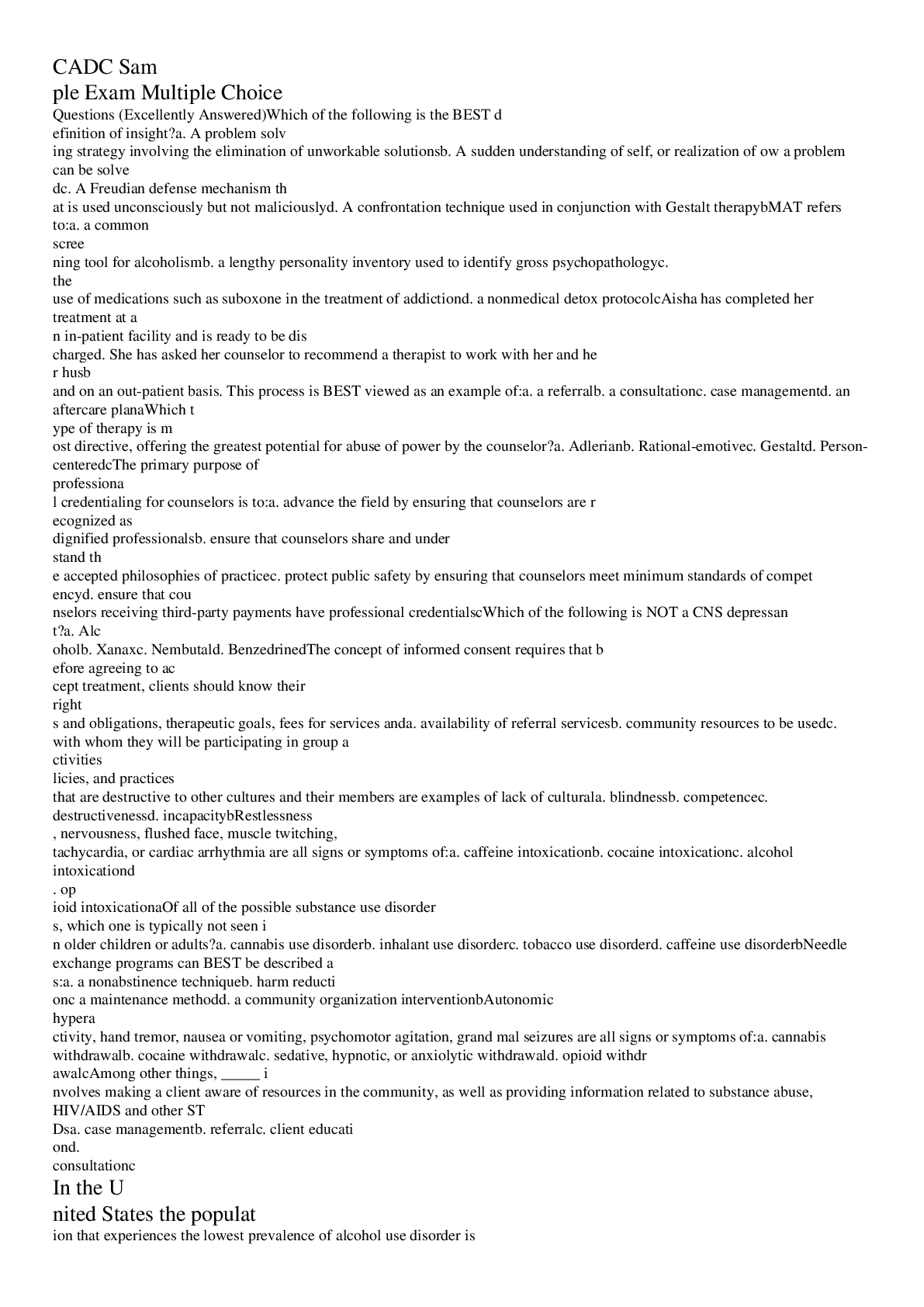
Buy this document to get the full access instantly
Instant Download Access after purchase
Buy NowInstant download
We Accept:

Reviews( 0 )
$10.00
Can't find what you want? Try our AI powered Search
Document information
Connected school, study & course
About the document
Uploaded On
Oct 16, 2022
Number of pages
12
Written in
All
Additional information
This document has been written for:
Uploaded
Oct 16, 2022
Downloads
0
Views
307

